Technology Outlook 2023
DE readers provide a glimpse of their engineering technology usage in our annual survey.

In the annual Technology Outlook, DE readers give their expert takes on their use of design and simulation technology. Image courtesy of Getty.
Latest News
December 27, 2022
As we reach the end of 2022, Digital Engineering has asked its readers to provide insight into their use of design and simulation technology.
After three years of disruption due to an ongoing pandemic, supply chain bottlenecks, a war in Europe, high inflation and economic uncertainty, the engineering and design space remains fairly strong. This year, we did see some declining revenue reports from vendors, largely in the hardware sectors (workstations, 3D printers), but demand for the technology we cover is increasing, and usage among our readership is holding steady. Our annual Technology Outlook survey is reflective of those trends—for the most part, there has not been much change since 2021.
Once again, we have asked Digital Engineering’s audience for their perspectives on the current and future technologies that are shaping design engineering work, along with the products and systems that they are designing.
We received responses from more than 250 readers. The largest group of respondents described their primary role as product or system design engineering (32%), followed by engineering management (13%), research & development (12%) and corporate management (9%). Respondents were spread among market sectors, with the majority working in aerospace/aviation/defense, industrial machinery and products, electronic products and equipment, and automotive.
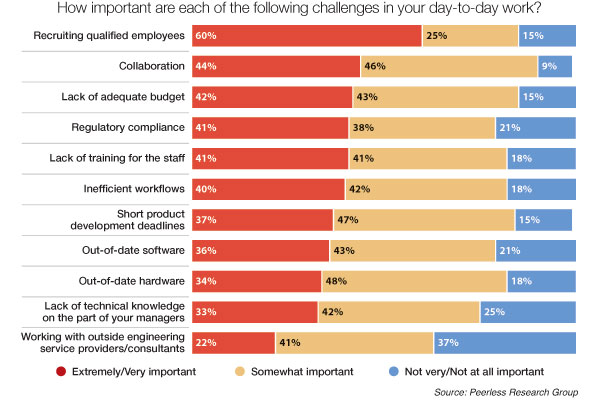
Designers Struggle with Collaboration, Staffing
For the fourth year in a row, collaboration was listed as an extremely/somewhat important challenge in the day-to-day work of design engineers. Collaboration was listed as the top challenge this year, considered very or somewhat important by 91% of respondents.
Recruiting qualified employees was another critical challenge, which makes sense given the tight labor market throughout the pandemic. In fact, while 85% considered recruitment extremely or somewhat important, a much larger percentage fell into the extremely/very important category (66%) compared to those who listed collaboration as an extremely important challenge (44%).
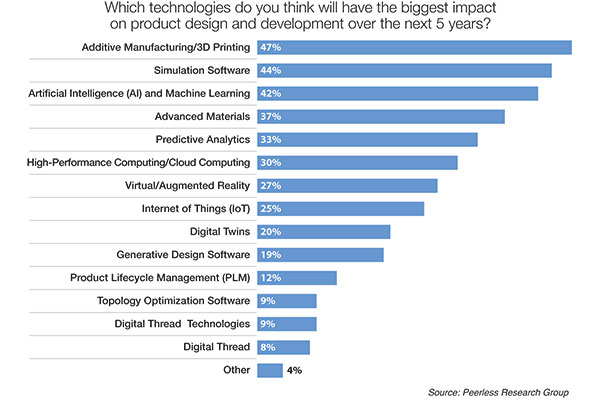
Other key challenges included a lack of adequate budget, short product development deadlines, inefficient workflows and out-of-date hardware.
Designing With Sustainability in Mind
In 2021, we asked our readers about efforts to incorporate sustainability principles into their design workflows. This year, 35% of respondents indicated that sustainability concepts were extremely important to their design/engineering activities (up from 30% last year), and 46% considered it somewhat important (up from 44%).
When we drilled down further with respondents who indicated that sustainability was important, they indicated that customer demand was often driving these efforts, along with corporate initiatives, cost savings and the ability to market themselves as a green company. According to respondent comments:
“The size, shape, color, material choices made by a designer and/or engineers will ultimately determine the size of the ecological footprint. By making informed decisions, designers/engineers can reduce their environmental impact, resulting in less greenhouse gas emissions and a more efficient use of natural resources. My organization is adopting a life-cycle thinking approach in all engineering activities.”
“Our company has been in the forefront of protecting the environment for decades. It is the right thing to do, to design with the environment in mind.”
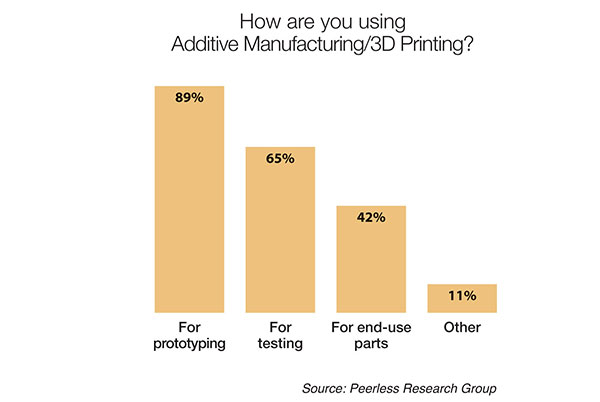
“Our firm is a product R&D firm with emphasis on sustainability throughout, including the end product. Energy usage, materials safety, sustainable materials selection, production process and takeback integration are core parts of our value system.”
Additive, Simulation, AI Still on Tap
When asked which technologies our readers thought would have the biggest impact on product design and development over the next 5 years, additive manufacturing and artificial intelligence (AI) have traded the top two spots over the past several surveys. Last year, AI and simulation tied for the top spot, but this year additive led the category with 47% of respondents, followed by simulation at 44%. AI/machine learning was a close third at 42%.
Additive manufacturing has received increasing attention for prototyping and, increasingly, end part applications, while AI is steadily being incorporated into design processes. Use of simulation continues to expand as well, as tools become easier to use and accessible by a wider range of stakeholders in the design cycle.
Those top three slots were followed by advanced materials (37%, up slightly from last year), predictive analytics (33%), high-performance/cloud computing (30%), virtual/augmented reality (27%), Internet of Things (25%) and digital twins (20%). Generative design lost ground for the second year in a row, dropping to just 19% (down from 30% in 2020).

Simulation Top of Mind
As in previous surveys, we asked readers what technologies they were currently using or developing products for, as well as which technologies they expected to adopt in the next 2 years. As was the case in previous years, simulation software held steady as the technology that most readers were currently using, with 53% reporting that they were doing so (down from 59% last year). Additive manufacturing/3D printing was second at 42% (up slightly from 40%).
Those were followed by product lifecycle management (PLM; 37%), IoT (30%), advanced materials (29%) and high-performance/cloud computing (28%). All of those figures were within a percentage point or two of the results from last year.
In the next two years, 28% of respondents plan to incorporate AI/machine learning in their design/development processes, with 26% planning to use HPC/cloud computing. Digital twins came in third for future use (25%), with generative design and IoT tied at 24%.
Digital twins and virtual reality/augmented reality tied for second place, with 22% of respondents planning to incorporate those technologies. HPC/cloud followed at 21%, with predictive analytics fourth at 20%. Generative design dropped from second to fifth place (26% last year; 19% this year), while additive manufacturing dropped from 23% to 19% of respondents.
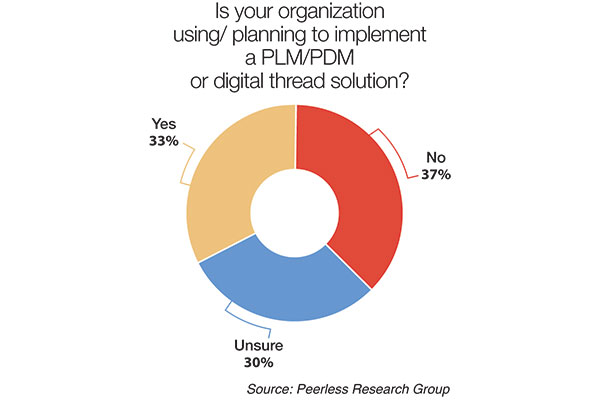
Additive Manufacturing Trends
The number of additive manufacturing users that focus primarily on prototyping increased this year to 89% from 83% last year. Testing applications were up as well, from 56% in 2021 to 65% this year. End-use part printing increased slightly from 39% of current users to 42%.
Cost justification for additive manufacturing technology continues to focus on efficiency, with the majority of respondents (91%) citing shortening product development schedules as either extremely/very important or somewhat important, followed by reducing/controlling development costs, reducing/controlling manufacturing unit costs, reducing part complexity and manufacturing designs that were not feasible with traditional methods.
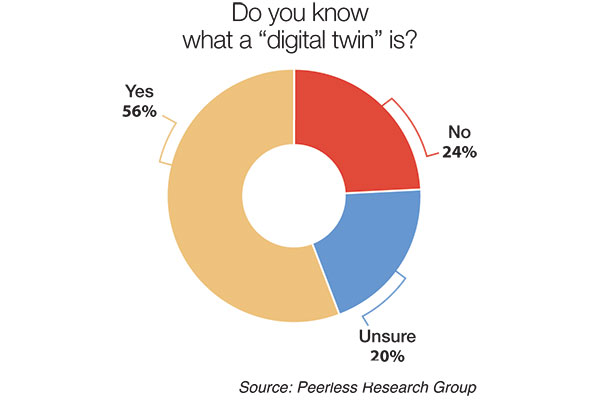
Generative Design Still Nascent
Although generative design and the use of AI in design processes continue to generate much press and new product releases from vendors, adoption is still relatively low (and flat). Just 16% of respondents are currently using generative design (the same as last year) and 22% are using AI/machine learning (compared to 21% last year). Future adoption plans are also growing slowly, with 24% planning to use generative design in the future (19% last year) and 28% planning to use AI (up from 21% last year).
Satisfaction with generative design among current users was high for helping engineers be more productive, with 69% of users saying they were extremely/very satisfied with the technology’s performance. Fifty-four percent of users were also extremely satisfied with generative design’s ability to shorten product development schedules, reduce product manufacturing costs, reduce weight, foster innovation and discover new designs.
Most users reported positive impressions of generative design, noting that it can accelerate design space exploration and help identify potential designs that users may not otherwise have come up with on their own. According to one respondent:
“In my opinion, generative design is an evolutionary way of approaching engineering and design in the digital era. With the generative design approach, you can broaden your horizon beyond your imagination and experience. It is an amazing tool to collaborate with technology for creating better with less. Generative design software is a common use case for my organization, as the organic shapes generated by computer-aided design and engineering tools with this capability are striking compared to conventional designs.”
Familiarity with digital twins is increasing as well. When asked if they knew what a digital twin was, those responding “yes” grew from 45% in 2020 and 51% in 2021 to 56% this year. Still, 21% of respondents claimed to be not at all familiar with the concept. Adoption of digital twins is still just at 13% (almost the same as 2021), while those planning to deploy grew from 22% to 25%.
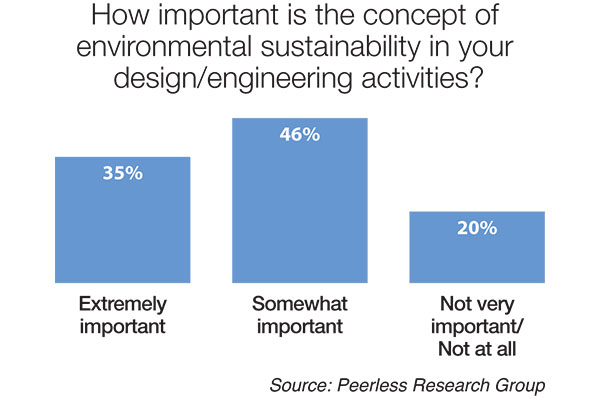
Additive Revolution?
When asked what technologies would revolutionize the design engineering process, the largest number (58%) strongly agreed that it would be additive manufacturing/3D printing (exactly the same as in 2021). Simulation-led design was second, with 54%. Once again, cloud-hosted solutions, big data/analytics, generative design and virtual reality were essentially tied for third.
Asked about familiarity with various technologies, simulation again led with 82% of respondents being very or somewhat familiar, followed by additive manufacturing (81%), IoT (70%), HPC/cloud (74%) and PLM (69%).
At the bottom of the familiarity scale, digital thread ranked lowest, with 27% of respondents being not at all familiar with it. Topology optimization was unfamiliar to 25% of respondents, and digital twins were listed as unfamiliar to 21% of those surveyed.
Subscribe to our FREE magazine, FREE email newsletters or both!
Latest News
About the Author
Brian Albright is the editorial director of Digital Engineering. Contact him at [email protected].
Follow DE





